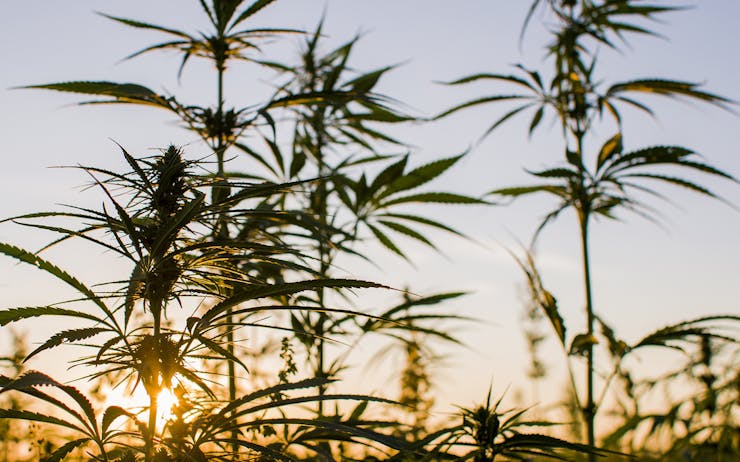How Cannabis Strain Genetics Influence the THC:CBD Ratio

Why do strains like Blue Dream and Harlequin have such different effects? In large part, it’s because they have very different THC-to-CBD ratios.
THC and CBD are the two most abundant cannabinoids in most strains. THC is well known as the major psychoactive compound. CBD is best known for having a wide range of medical uses. While CBD lacks the psychoactive properties of THC, it does influence the effects of THC in the brain. This is why the THC:CBD ratio strongly influences a strain’s effects, and why that ratio is important when deciding which strain is right for you.
Here’s the cool part: The THC:CBD ratio is largely determined by strain genetics. Each plant’s genetic code determines the way the plant produces the two compounds. It’s a fascinating process that many consumers aren’t aware of.
How the Plant Produces THC and CBD
THC and CBD are both made from another cannabinoid called cannabigerol (CBG). Within cannabis plants, each of these compounds is actually present in a slightly different, acidic form. The plants are really making either THCA or CBDA out of CBGA (Figure 1). It’s only after THCA and CBDA are decarboxylated by heat that we get significant levels of THC and CBD. The heat energy from your vaporizer, lighter, or oven causes a chemical reaction that turns THCA and CBDA into THC and CBD, respectively.
THCA and CBDA don’t have the same effects as their “activated” (decarboxylated) counterparts. Remember that scene in Super Troopers where the guy eats a bag of cannabis flower and goes out of his mind? That wouldn’t really work, because flower contains mostly THCA, which isn’t psychoactive. You would have to heat the flower at the right temperature first, turning the THCA into THC, before eating it would get you high.
A single CBGA molecule can turn into a single THCA or CBDA molecule, but not both. How does the plant decide which to make? That depends on the presence of an enzyme that comes in two flavors. Let’s call them Enzyme 1 (E1) and Enzyme 2 (E2).

Figure 1: The cannabis plant synthesizes both CBDA and THCA from another cannabinoid molecule, CBGA. Despite the fact that CBDA and THCA are made from the same precursors, their effects are very different. The genetics of each plant determines how much CBDA vs. THCA gets produced (see below). (Photo credit: Amy Phung/Leafly)
E1 takes CBGA and converts it into CBDA, while E2 converts CBGA into THCA (Figure 1). Some strains only have E1, some only have E2, and some have both.
Strain Genetics Determine the THC:CBD Ratio
Like most plants and animals, cannabis plants inherit two copies of their genes. As it turns out, the E1 and E2 enzymes that turn CBGA into either CBDA or THCA are encoded by two different versions of the same gene (in reality things are a bit more complicated than this, but the end result is the same). Because each plant gets two copies of that gene, there are only three possibilities: A plant can have two copies of the gene that encodes the E1 enzyme, it can have one copy each of the genes that encode E1 and E2, or it can have two copies of the gene that encodes E2 (Figure 2).

Figure 2: The genetics of a cannabis strain determine whether it produces only CBDA, only THCA, or both. The E1 enzyme converts CBGA into CBDA, while the E2 enzyme converts CBGA into THCA. Two versions of the same gene encode E1 and E2. A plant can have two copies of one version of this gene, or it can have one copy of each. (Photo credit: Amy Phung/Leafly)
Importantly, these three possibilities are based solely on the THC:CBD ratio, and don’t take into account other compounds that a particular strain might produce. The three broad THC:CBD ratio strain categories are:
- CBD-dominant strains (hemp): If a strain gets two copies of the gene that makes E1, only CBGA to CBDA is possible. These strains will have high levels of CBD and negligible levels of THC. Charlotte’s Web is the most famous strain in this category.
- Balanced strains: If a strain gets one copy each of the E1 and E2 genes, it will produce CBDA and THCA at somewhat similar levels. Let’s call these “balanced strains”—they produce both CBDA and THCA. Strains like Harlequin or Cannatonic are good examples.
- THC-dominant strains: If a strain inherits two copies of the E2 gene, only CBGA to THCA is possible. These strains make up most of what we see on dispensary shelves today. Blue Dream, GSC (f.k.a Girl Scout Cookies), and the bulk of commercial strains fall into this category. They have high THC levels and negligible CBD.

Figure 3: The THC:CBD ratio is determined by whether a strain has only the E1 enzyme, only the E2 enzyme, or both. Strains with only E1 (hemp) will end up with only CBD, while strains with only E2 will end up with only THC (most commercial strains). Strains with both E1 and E2 will be “mixed,” and have both CBD and THC. (Photo credit: Amy Phung/Leafly)
Cannabis genetics limit THC and CBD production so that only these three broad categories of flower are possible. Hemp strains do not produce significant levels of THC, while most commercial strains fall into the THC-dominant category—they have THC but negligible levels of CBD. “Balanced strains” produce both THC and CBD, but generally not as much THC as THC-dominant strains or as much CBD as the more potent hemp strains.
In the next article of this series, we will explore more precisely what the limits on THC and CBD levels are for each of these categories. Later on, we’ll consider some of the effects you may experience when consuming strains with different THC:CBD ratios.





